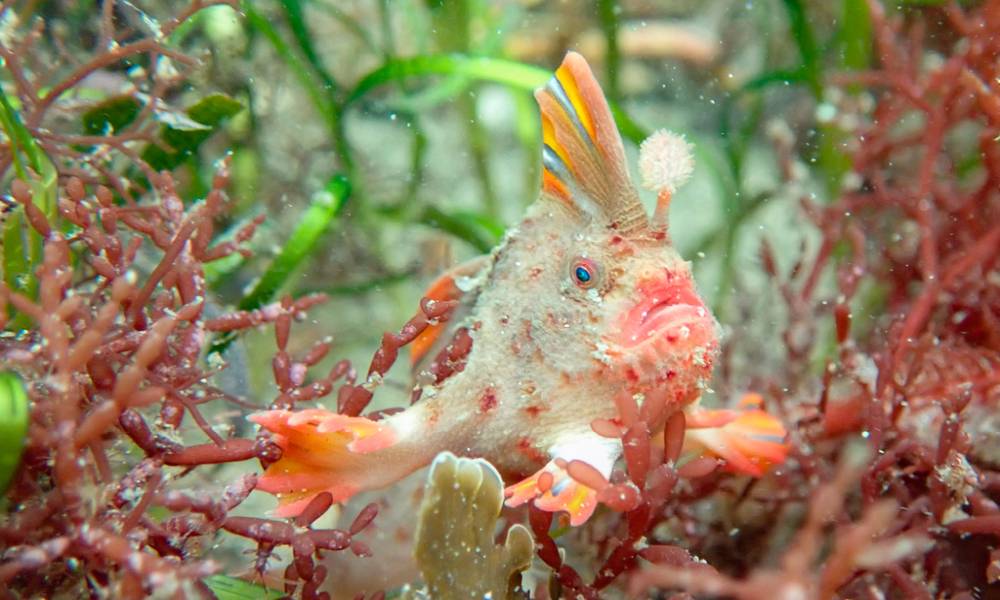

Red Handfish
An Incredible Fish on the Edge of Extinction

INTRODUCTION
The Red Handfish (Thymichthys politus) is an incredibly interesting and unique fish that lives in Australia, where so many other one-of-a-kind species are found. Known for its extraordinary, hand-like fins, it is considered one of the most distinctive fish species in the world.
Scientific Classification
• Kingdom: Animalia
• Phylum: Chordata
• Class: Actinopterygii
• Order: Scorpaeniformes
• Family: Brachionichthyidae
• Genus: Thymichthys
• Species: T. politus
Appearance and Behavior
The body length of a Red Handfish is less than 3.5 inches (9 centimeters). When mature, they have a vibrant red coloration and blue eyes, colors that are believed to serve as a warning to potential predators. These traits show predators that the Red Handfish is not an easy target, which shows remarkable adaptability and survival strategy.
The rounded, fleshy appendage on the top of the Red Handfish’s head is known as an illicium. It is adorned with tiny light-producing organs called photophores. When the Red Handfish waves its illicium, it creates a flickering light that attracts small fish and crustaceans, which it strikes with its sharp teeth. Even in the dark, the illicium allows it to attract prey.
The Red Handfish has a most unusual mode of locomotion. Rather than swimming, as most fish do, it uses its hand-like fins to walk along the sea floor. This unique method of moving about has not only captured the interest of researchers but also led to its unusual common name.
Because of their walking behavior, they are solitary creatures with limited mobility. They often inhabit an area of a few square meters for their entire lives, providing further evidence of their uniqueness but also limiting their survival as a species.
Habitat and Ecology
The Red Handfish is found in the temperate, but cold, coastal waters of southeastern Tasmania, Australia, both areas are known for their rich biodiversity. This small species lives close to the shore, often on rocks, within large seaweeds, or in sandy patches near reefs. It commonly hides beneath the Sargassum seaweed on the reef. Their lifespan is around 11.5 years under natural conditions, and they feed primarily on small invertebrates such as crustaceans and worms.
Red Handfish are oviparous, laying up to 60 eggs that are then fertilized externally. After laying her eggs, the female displays great parental care and will guard them. She also has a routine to fan them, keeping them oxygenated until they hatch, a process that usually takes 6 to 7 weeks but can take up to eight weeks.
Conservation Status
The Redhand Fish, known for its hand-like fins, is a unique marine species. It was last assessed in 2018 and listed as critically endangered on the International Union for Conservation of Nature’s (IUCN) Red List of Threatened Species. It is estimated only about 100 adults are left in the world. Today, conservation actions are imperative due to threats such as climate change, siltation, habitat loss and degradation, water pollution, and high densities of sea urchins. Protecting its habitat is essential for marine biodiversity.
THREATS TO RED HANDFISH

Current Extinction Status of the Red Handfish
The Red Handfish currently holds the dubious distinction of being the world’s rarest fish species. According to an article in The Conversation, “There are just two small areas near Hobart, and therefore in the world, where the red handfish is known to still live, amounting to a wild population of around 100 adults.”
With such low numbers of remaining individuals, it may soon face the fate of its relative, the Smooth Handfish, which was the first marine fish to be declared extinct in modern times. Such a small population also implies a severe reduction in genetic diversity, amplifying the species’ susceptibility to diseases and environmental changes.
The Red Handfish lives chiefly in the Fredrick Henry Bay Reserve, South Arm Marine Reserve, and the Port Arthur Marine Reserve. These reserves help to protect them, and they are complemented by other measures, including fisheries regulations, habitat restoration, education, and outreach. While all these measures provide desperately needed help for the Red Handfish, multiple factors still contribute to the declining fate of this unique fish.
Protective Measures and Anthropogenic Threats
Red Handfish face many diverse threats to its survival. Many are caused by human activities. Coastal development projects, even those inland, are encroaching upon or causing damage to the seafloor habitat that the Red Handfish requires, and this issue has progressively worsened. Because this species lives within a tiny area and does not migrate much beyond these areas, habitat displacement and destruction are especially deadly to it.
Climate Change Impacts and Resulting Shifts
Worsening climate change is one of the nine planetary boundaries that is causing a serious threat to the Red Handfish’s existence since it introduces drastic alterations in the marine environment. The Red Handfish is a species that thrives in colder water environments, and the relentless rise in sea temperatures, brought about by climate change, directly threatens their required living conditions. Warmer waters lead to the alteration or even destruction of their required habitats, effectively destroying them.
Climatic changes also bring about various secondary effects that compound the threat. For instance, warmer waters lead to shifts in the availability and distribution of food resources, either by affecting the life cycles of prey species or changing the composition of local ecosystems. Adapting to these changed conditions is not possible in the short term, and with only one hundred left in the wild, time is against this occurring before the species is driven into extinction.
Predation and Competition
Even as warmer waters are a curse to the Red Handfish, they will benefit predatory species migrating into their habitats. Larger marine species, such as fish and octopuses, are known predators of the Red Handfish, and one invasive fish species already present in their habitat is the Northern Pacific Sea Star, which has been observed consuming Red Handfish. Other newly introduced species, also more suited to warmer conditions, may out-compete the Red Handfish for food, living spaces, and other resources. Egg and juvenile developmental periods expose special vulnerabilities for the Red Handfish to predation by other species. The impacts of climate change, particularly the warming of sea waters and the increase of sea urchins, cast a long shadow over the survival of the Red Handfish.
Pollution, Disease, and the Critical Need for Conservation Efforts
Pollutants, particularly those emanating from plastic waste and chemical runoff, have substantial negative impacts on the Red Handfish and other species. Pollutants can annihilate their habitat, drastically reduce food availability, and directly harm the fish through either ingestion or exposure. The broad-spectrum damage caused by pollution poses a significant and ongoing threat to the well-being and survival of this species and others.
Red Handfish are also susceptible to various diseases, including skin infections, parasitic infestations, and disorders affecting their respiratory systems. Their heightened susceptibility to these diseases, owing to lower genetic diversity, together with the potential threat of new pathogens being introduced due to shifts in water quality or temperature and the incursion of non-native species and the illnesses they carry, may well quickly cause the complete annihilation of this species in the wild.
With only 100 adults known to exist, there is a critical need for concerted efforts in research, public awareness, strict law enforcement, and habitat conservation. The survival of the Red Handfish is threatened by the factors already discussed and others, and there should be no doubt that any one of them alone could push this species into extinction!
IMPORTANCE OF RED HANDFISH

Financial Costs of Red Handfish Extinction
Only found in Tasmania, the Red Handfish (Thymichthys politus) will seem remote to people not living in Australia, but its decline into an extremely precarious existence and the efforts to conserve it have financial ramifications for both local citizens and those of other nations, including developed countries. Despite their small size, the costs associated with their decline and possible extinction travel across oceans and borders, reaching the wallets of the average citizen in various ways.
One of the immediate costs related to the conservation of the Red Handfish is the substantial expenditures required to fund research and protection efforts. Money used to fund these endeavors often comes from international organizations and governments, which in part are paid for by the citizens of developed nations. Direct and indirect costs are tied to these activities, from conducting scientific research to implementing and enforcing protection measures.
Impacts on Local Ecosystems
The disappearance of the Red Handfish will bring about a series of cascading effects on its local ecosystem. Though limited by the low numbers of surviving members, like all species, the Red Handfish provide services and play specific roles in their ecosystem. Red Handfish are a food source for other species while also helping to control the population of their prey, thus maintaining ecological balance. When this biosphere is disturbed because of the possible extinction of the Red Handfish, it will cause noticeable problems such as the overpopulation of certain species and depletion of others, potentially leading to costs associated with ecological restoration and management. These imbalances potentially will disrupt food chains, leading to population explosions of certain species and declines or even extinction of others that have depended on the Red Handfish, either as predators or prey. In all ecosystems, it is required that all inhabitants function effectively together, and losing even one species can have dire consequences.
Effects on Climate Change and Associated Costs
At first glance, the disappearance of a fish species with very limited numbers, like the Red Handfish, might seem inconsequential in the broader context of global climate change. However, the Red Handfish contributes to the robustness of the marine ecosystem in which it lives. Losing them disrupts the intricate balance within their habitat, reducing the ability of the ecosystem to absorb carbon dioxide, regenerate, and maintain healthy populations of other marine organisms. This speeds up climate change and affects the functioning of the ecosystem in a loop, leading to more species difficulties and climate change.
The effects of these ecosystems on climate change cause additional resources to be devoted to mitigation strategies required to curb the pace of climate change and restore ecological balance. These efforts include initiatives to reduce carbon emissions, restore damaged habitats, and reestablish biodiversity. They come with significant costs.
Reducing carbon emissions involves transitioning to renewable energy sources, which require substantial upfront investments. Habitat restoration often includes expensive tasks like cleanup operations, replanting native species, and ongoing monitoring to ensure a successful recovery. Captive breeding programs, reintroduction initiatives, and the continued monitoring of these species to ensure their survival in the wild are all resource-intensive undertakings, making the costs of reestablishing biodiversity colossal.
Impact on Fisheries
Any changes to an ecosystem caused by the loss of a species, including the Red Handfish, alters the conditions for other marine life, affecting the health and abundance of commercially significant species. While this species is not a huge factor in commercial fishing operations, its demise will lead to a small decrease in fishery yields and increased operational costs for the fishing industry. As with most production costs, any additional costs are eventually passed on to consumers, resulting in inflated fish prices and other seafood products.
Costs of Legislation and Enforcement
The protection of species comes about through legislative measures and policies put in place to protect endangered species like the Red Handfish. Enforcing these policies, monitoring their effectiveness, and ensuring compliance requires substantial resources. These costs are necessary to prevent extinction and conserve biodiversity, but they add additional strains on budgets and the allocation of funds that could be used elsewhere. All are paid for by the taxpayer. Protecting endangered species is not just an environmental issue; it is also an economic one.
Loss of Ecotourism Potential
The Red Handfish is known for its distinctive looks, generating interest in its rare status. This holds great potential for spurring ecotourism. Ecotourism emphasizes responsible travel to natural areas that conserve the environment. This helps sustain local populations’ financial well-being, often by including education and interpreting. The presence of a unique and endangered species like the Red Handfish significantly enhances the attractiveness of an area for eco-tourism. It is a win for endangered species and local industries.
As populations of this species continue to decline, or if the species becomes extinct, these potential ecotourism opportunities will be forever lost. On a local level, communities that could have benefited from the influx of tourism will lose a valuable source of income. The loss of ecotourism potential also impacts the global economy as a whole since this industry contributes billions of dollars each year. Extinctions of species like the Red Handfish diminish the overall appeal of global biodiversity, possibly deterring potential tourists and reducing revenues from this industry.
The Bottom Line for the Red Handfish
This beautiful fish, while a small and remote creature, has broader implications for global economies and the average citizen of developed countries. Its role in biodiversity and climate change mitigation highlights the importance of protecting this unique species. The financial costs of protecting biodiversity are high, but the cost of losing it is much higher.
HOW TO HELP RED HANDFISH

The Importance of Individual Efforts in Conservation
Individual efforts are vital in preserving unique species like the Red Handfish. The fight to preserve this species does not exist in a vacuum. The loss of biodiversity is global and involves millions of species. The Red Handfish, unique as it is, is only one species of millions facing extinction by 2050.
Species losses are caused by a complex matrix of local and global issues, such as climate change, pollution, and habitat loss. Addressing these challenges demands local and global cooperation by leadership dedicated to implementing worldwide solutions. These actions are not optional. The clock of extinction for this species and others, including us, continues to tick onward if we fail to take action to stop it.
Advocacy for Effective Legislation and Policies
Ensuring effective legislation and policies is crucial for protecting endangered species like the Red Handfish and our planet’s health and sustainability. Advocacy plays a pivotal role in influencing and shaping these laws and policies. The more voices that are heard, the greater the chance that these concerns will be taken seriously at the decision-making level.
Voicing concerns to your elected representatives about the various threats endangering the existence of this species and our planet is one way to be involved. The issues range from climate change, overfishing, and pollution to the illegal pet trade, significantly contributing to biodiversity losses. The bottom line is that if your politicians do not support protecting our planet, then vote them out and replace them with those who will.
By contacting representatives through letters, emails, calls, or even town hall meetings, you convey the importance of these issues, urging them to act. In addition, participation in public consultations and policy forums can also be effective. These platforms provide an opportunity to engage with the broader community, policy-makers, and stakeholders to promote policies prioritizing biodiversity conservation and sustainable practices.
Another key aspect of advocacy is forming or joining coalitions with like-minded individuals or organizations. The Handfish Conservation Project is one of the few dedicated to preserving the Red Handfish. The University of Tasmania, Red Handfish Project, has devoted extensive time and resources to birthing this species in captivity to release them into the wild after a year of development when they will be more able to survive.
These coalitions, and others, can collectively push for stronger environmental laws and regulations, and their combined strength can significantly increase the chances of effecting policy change. Providing support to such initiatives, either through financial donations or by volunteering your time, can significantly aid their conservation efforts. Funds donated to reputable organizations like these are utilized to conduct research, protect habitats, and run awareness campaigns.
Lastly, educating others about the importance of the Red Handfish and policies that can help protect it can garner more support for them. Many people may not understand the intricate links between legislation, biodiversity, and climate change. By breaking down these complex topics and demonstrating their direct impacts on our lives and the lives of species like the Red Handfish, we can encourage more people to take action.
Embrace Sustainable Lifestyle Choices and Responsible Ecotourism
If we make sustainable lifestyle choices, we can contribute to reducing the environmental degradation that threatens species like the Red Handfish and the planet. These include choices such as reducing our plastic usage, recycling, and minimizing carbon footprints.
Each small step, while seemingly insignificant, can positively impact preserving the biodiversity of all species, including our own, when joined with others’ efforts. Visiting areas with rich biodiversity, such as Tasmania, is an amazing experience. Traveling to places where the Red Handfish is found, when accomplished using low-impact and environmentally-conscious travel options, can help protect these unique ecosystems.
Your Role in Saving the Red Handfish
Whether it’s through raising awareness, supporting conservation projects, advocating for effective legislation, or making sustainable lifestyle choices, every action we take brings us a step closer to ensuring the preservation of this unique species and the Earth. By taking active steps towards conservation, you contribute to maintaining the rich biodiversity that our planet offers and that we need to survive.












